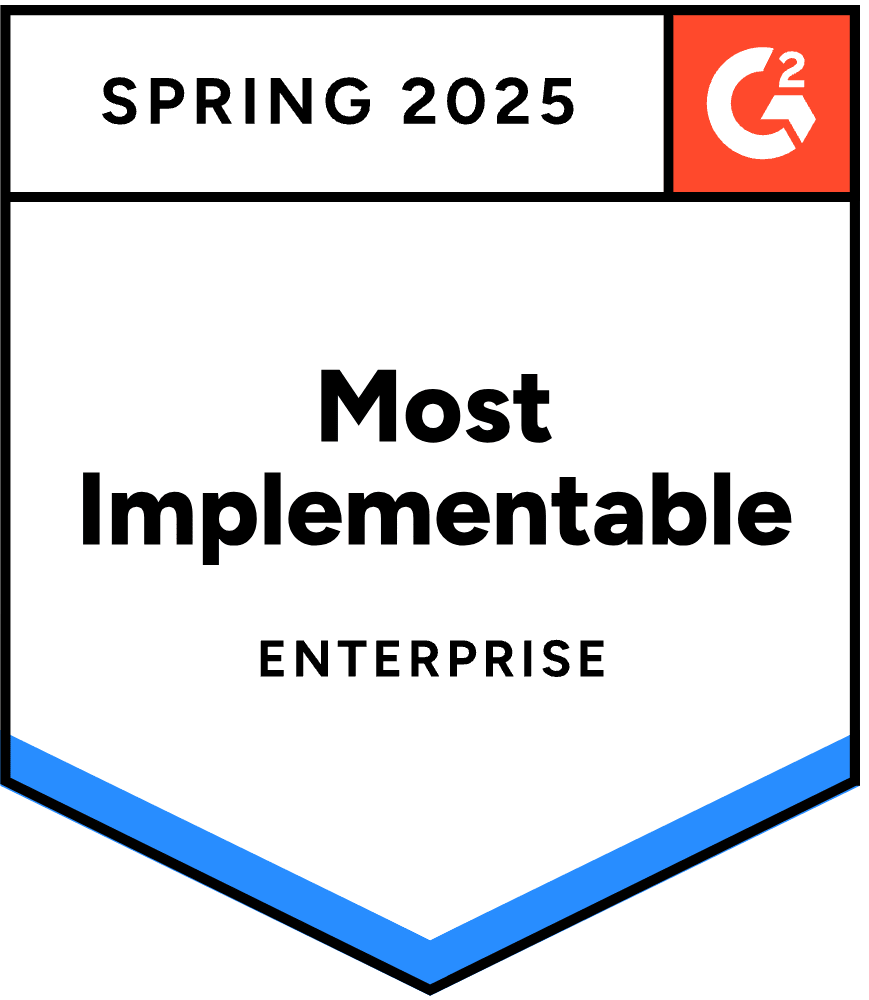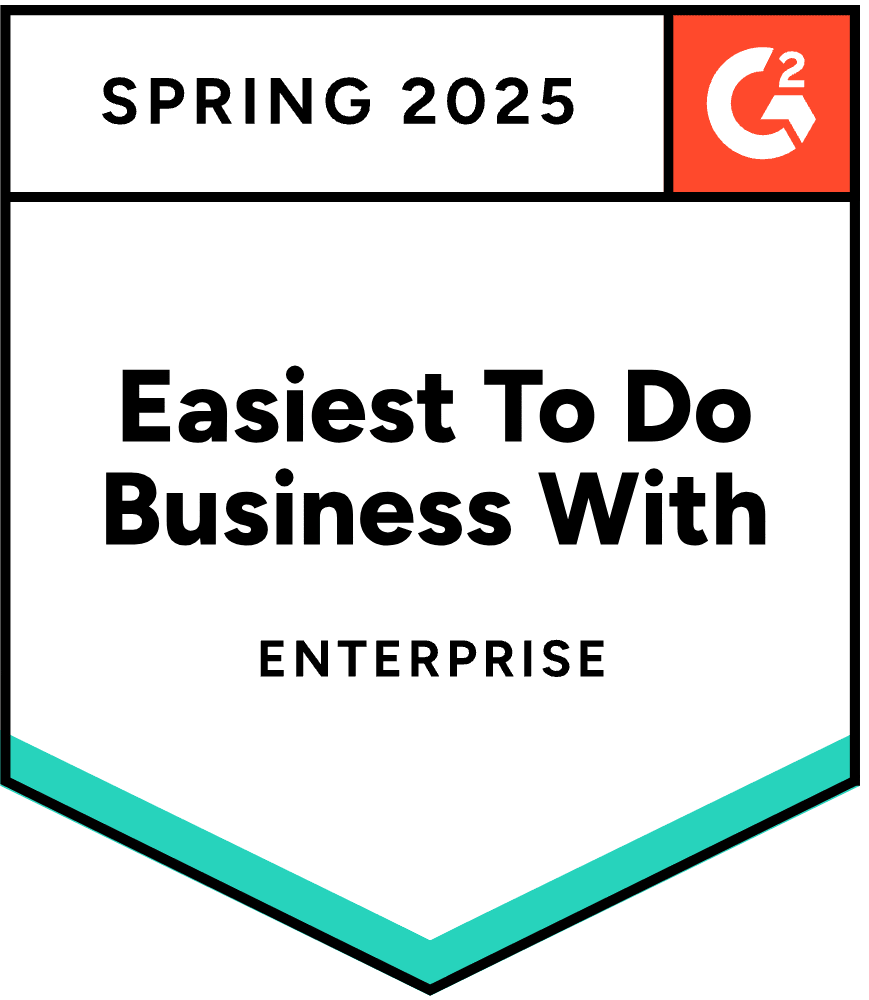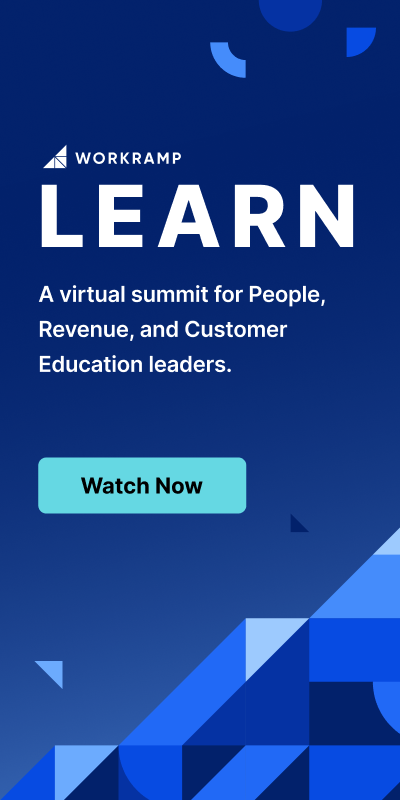Training Content Toolbox: 14+ Types to Boost Your Business
Michael Keenan | WorkRamp Contributor
View bioLearning Tips Straight to Your Inbox
Training is a critical driving factor in employee engagement and performance. The average organization spends $1,280 per team member on employee training each year, according to ATD’s 2022 State of the Industry report.
To get the best bang for your buck, you want training content that’s relevant and engaging.
Sometimes, it’s nice to have inspiration to get the wheels moving for creating a successful training program.
Discover the best training content to add to your program to boost employee learning.
In this post:
What is training content?
Training content is any material that informs and educates employees. It can take many forms, including text, audio, images, videos, simulations, and interactive activities.
You can use training content to teach anything from basic business skills to complex technical topics to enhance employees’ knowledge, skills, and professional development.
Examples of training in the workplace
Workplace training is a huge umbrella that covers numerous subtypes of training, dealing with areas that range from coaching and safety to onboarding and compliance.
Here are a few common examples of employee and customer training:
- Annual compliance training
- Customer service/support training
- Leadership development
- Customer onboarding
- New hire onboarding
- Product training and education
- Role- or industry-specific technical training
- Safety training
- Sales training
- Soft skills training
While training programs vary in their scope and nature, most of them involve an element of either upskilling or reskilling.
Upskilling involves teaching employees more advanced skills to help them transition into more senior or demanding roles. Reskilling, on the other hand, involves teaching completely new sets of skills to employees—often as a measure to help companies adapt to game-changing technology.
The Learning Cloud from WorkRamp, makes it easy to create and deploy training programs that fill knowledge gaps for customers and skill gaps in your organization. For example, you can use the Learning Cloud to build a custom training program emphasizing soft skills development, leadership development, or even customer and partner certification programs.
Turn customers into brand champions and employees into experts with a flexible learning management system designed to make your training and L&D initiatives easy to manage. The Learning Cloud makes it fast and simple to build content, track progress, and improve business outcomes.
13 Training content types to know
Training turns boring and unengaging for the learner when the content is repetitive or difficult to absorb.
That leads to poor knowledge retention and more difficulty mastering new skills. In turn, that leads to lower customer and employee satisfaction—and a less effective organization with higher rates of employee turnover and customer churn.
You can avoid these hurdles by ensuring your training is dynamic, relevant, and capable of holding learners’ interest. That means you should strive to incorporate as many types of content as possible into your training program.
Using numerous training content types, you can communicate information more clearly while appealing to a broader range of learning styles and preferences.
While the list below isn’t exhaustive, it will give you a solid starting point for building effective training content.
Here are 13 formats to explore, from slides, videos, and GIFs to guides, flip cards, and checklists.
Slides
Presentation slides are a great way to convey ideas, concepts, and information. You can turn instructional materials into a slide presentation and add photos, videos, animations, and other interactive elements to engage learners.
Pros:
- Commonly used and easily recognizable
- Can be visually appealing and present information in a clear manner
- Can include interactive elements like quizzes, hyperlinks, and animations to improve engagement and retention
Cons:
- Can quickly become monotonous and lead to passive information consumption
- Learners must give their full attention to consuming information, which can be hard on a mobile device with distractions
To illustrate this with a real example, imagine giving a presentation about customer service best practices. You can create a slide deck about different ways to handle challenging customer service situations. Learners can then download the slides and use them as reference points in the future.
💡 Po Tip: L&D teams must ensure slides are always accurate and current. The Learning Cloud makes editing and updating your slides easy to include new information and showcase your organization’s values.
Visuals
Good visuals make it easy to convey information. For example, you can use visuals to explain a process, identify key elements, and show how something works.
Pros:
- Illustrate complex concepts and make information easier to understand
- More engaging and memorable than text-based content
- Learners can understand visuals regardless of language barriers, which makes training more accessible
Cons:
- Learners can misinterpret information if it’s designed or presented incorrectly
- Creating high-quality visuals can require special design skills and tools
Visuals in learning content can be:
- Diagrams
- Charts
- Infographics
- Illustrations
- Photos
An example of a good visual is a process flow diagram. Graphics like this can outline steps in a process, show items related to the process, and identify any actions or tasks that need to be completed. It’s a great way for L&D managers to simplify an otherwise complicated process.
💡 Pro Tip: Use visuals to make a training course interactive and interesting, which makes the learning experience more enjoyable and accessible. For example, a manager can use visuals to help explain a complicated process or to give step-by-step instructions.
Learn more about strategies to make eLearning engaging.
Videos
Videos are an extremely popular tool for educating, informing, and inspiring. Video content is highly engaging, spans many topics, and can include animations, interviews, demonstrations, and more.
Learners can watch a training video on a mobile or desktop device, making this learning form convenient for employees who travel frequently or need to learn on the go. WorkRamp’s mobile-friendly design makes on-the-go learning easy, especially for remote teams that need to coordinate across different locations.
Pros:
- Can effectively hold the learner’s attention and make training more enjoyable
- Conveys emotions and builds connections with learners
- Can include interactive elements like polls that increase engagement
Cons:
- Limited interaction compared to other training formats like games or simulations
- Requires a certain level of technical infrastructure to be viewed on mobile
As an L&D manager, you can use video to:
- Provide an overview of a subject
- Reinforce a message
- Recap course content
Say you’re onboarding a new employee. You can create a video that includes a(n):
- Welcome message from the CEO
- Overview of company values
- Demonstration of online tools available
- Video tour of employee facilities
In one video, new hires will clearly understand the company and be better prepared to work there.
GIFs
GIFs are fun training content because they are light-hearted and memorable. In addition, they allow creativity, which makes them more engaging.
Pros:
- GIFs are small and can be loaded and viewed easily on mobile devices
- Ideal for demonstrating procedures or sequences
Cons:
- Limited color depth and resolution
- Animations and flashing images may not be suitable for all learners
Creating GIFs is easy:
- Find a GIF that matches the concept you want to illustrate
- Add a caption to GIF for extra content
- Add GIFs to a guide or video
GIFs can illustrate a process or concept or lighten up long guides with a funny joke or meme. GIFs are helpful for topics that are complex or require multiple steps.
💡 Pro Tip: To ensure GIFs are relevant, add additional information like captions, definitions, and key concept explanations.
Guides
A guide gives employees a comprehensive overview of the topic and can be used in many ways. For example, you can use a guide to explain concepts or topics within a course or provide step-by-step instructions to complete a task.
Pros:
- Easy for learners to follow and understand
- Self-paced and allows learners to review specific parts as needed
- Created in various formats, like PDFs, eBooks, or articles, making it easy to access and distribute
Cons:
- Lacks interactivity compared to videos or games
- Limited opportunities for asking questions or getting feedback on material
- Can become outdated quickly and needs to be continuously updated
Guides are easy to create and can be shared in various formats. Most guides contain simple outlines and paragraphs in Microsoft Word or Google Docs. The best, most comprehensive guides feature screenshots or visuals to explain complex concepts and procedures.
You can use the Learning Cloud to create interactive guides for learners. Add elements like quizzes and flip cards to test knowledge along the way.
Read more: eLearning Content: 24 Types to Include in Training
💡 Pro Tip: Include a glossary of key terms in your course guide. Use quizzes or activities at the end of the guide to help learners practice.
Flip cards
Flip cards are a series of cards learners can flip by clicking or tapping to reveal relevant concepts. They are a great tool for delivering learning content. You can also easily customize cards to be specific to the topic.
Pros:
- Ideal for presenting information in small, manageable chunks
- Easily adapted to a wide range of subjects and objectives
- Relatively inexpensive to create
Cons:
- Not suitable for delivering complex or in-depth concepts
- Can become monotonous for learners
- Require technology
You can arrange the flip cards according to the lesson you’re teaching. For example, you can arrange them according to the steps you are teaching if you’re explaining a new process. Another option is to increase the difficulty or complexity of the content as the learner progresses.
Checklists
Checklists are a simple and effective way to present information. They provide a step-by-step process that learners can follow and understand, and continuously refer back to.
Pros:
- Easy to retain information
- Can be used as a reference tool even after training is finished
- Easily created and managed through a Learning Management System (LMS)
Cons:
- Not suitable for complex topics with detailed explanations
- May be perceived as simplistic and not engage highly visual learners
Checklists are helpful for new employees becoming familiar with their jobs and more experienced associates completing skills training, making them a versatile tool.
For example, an L&D manager can create a checklist for a new research-oriented project that includes market research, customer feedback, competitor strategies, and technology investments.
Checklists also have another benefit: they keep everyone on the same page, helping you ensure that employees have the skills and knowledge to complete projects on time.
For example, an L&D manager can create a checklist for a new research-oriented project that includes market research, customer feedback, competitor strategies, and technology investments.
This checklist guarantees employees have the skills and knowledge to complete the project on time.
Interviews
Interviews give learners insights from industry experts. These can be experts within your organization or vetted external professionals. In addition, interviews help people better understand learning material compared to a traditional lecture or seminar.
Pros:
- Personal stories and experiences are powerful learning tools
- Bring content to life with real-world examples
- Foster community and connection among learners
Cons:
- Can be time-consuming and difficult to coordinate
- Legal or privacy considerations to consider
A good interview can provide insights, create interactive content, and engage learners more meaningfully. When L&D managers prepare well, they can create interview content to help employees learn and grow.
💡 Pro Tip: Plan out interview questions beforehand. Send the questions to your interviewee so they’re prepared and can articulate information properly.
It’s also a good idea to record the interview (even if it’s a live event) and provide a transcript for people who don’t want to watch.
Screenshots
Screenshots are an invaluable tool for learning and development managers for three reasons:
- They let learners see exactly what they need to do step-by-step
- They make it simple for learners to troubleshoot and resolve issues
- They make it easier to discuss a process with a group since everyone can view the same thing
Pros:
- Ensures clarity and accuracy during the training process
- Simple to create and edit to meet specific training needs
- Provides a visual representation of complex or abstract information
- Easily include other types of materials like presentations, videos, and courses
Cons:
- Can quickly become outdated if the software or platform changes
- Static images that do not provide an interactive experience
Say you need to explain a complex software process. Instructions may be lengthy and difficult to understand at first. Breaking down the instructions into smaller steps and accompanying each step with a screenshot makes understanding and comprehending easier for trainees.
💡 Pro Tip: Use screenshots along with written instructions. It’s essential to show and clarify how the process works, what needs to be done, and how to accomplish it. As a result, the user can visualize and comprehend the process without referring back to the instructions.
Podcasts
Podcasts are excellent for sharing a message or teaching specific concepts. In addition, you can host debates and discussions, invite experts from different disciplines, and present new information easily.
Read more: What is Mobile Learning?
Pros:
- Learners can listen to podcasts anytime, anywhere, and at their own pace
- Can include Q&A sessions, interviews, and relevant discussions
- Low-cost to produce
- Easy to access for learners
- Easy to measure success
Cons:
- Not suitable for training that requires visual aids
- Not interactive
With the right tools, podcasting is technologically straightforward. You can record audio and video on any computer and upload them in minutes. Many social media sites also have podcasting features, so you can share the podcasts you create easily.
Check out the LEARN Podcast to hear valuable insights and get inspired by the top leaders in SaaS.
Quizzes
Learners can use quizzes to test, verify knowledge, and retain information more effectively. In addition, quizzes provide feedback that helps learners adjust quickly to new concepts and change their approach if necessary.
Quizzes are great for managers to measure training effectiveness and understand comprehension.
Pros:
- Assess learners’ understanding
- Helps identify areas for improvement
- Interactive and keeps learners interested in the material
- Reinforces key concepts and information
Cons:
- Can be repetitive and boring if designed poorly
- Provide a pass/fail result with little feedback
The best ways to use quizzes in mobile training are to make them short and straightforward, like providing multiple-choice, fill-in-the-blank, or true/false question formats. It’s also important to provide feedback when someone answers a question incorrectly to improve understanding and retention.
Simulations
A simulation is a great way to teach learners new skills. It allows them to practice in a realistic setting where employees can make and learn from mistakes, without triggering real business consequences.
Pros:
- Let learners practice and apply concepts in a controlled environment
- Recreate real-life situations, making training more relevant
- Effective for assessing knowledge and skills
Cons:
- Developing and delivering simulations can be time-consuming and require technical expertise
- Can be expensive to develop
- Boring simulations can have the opposite effect and reduce impact
For example, if you’re teaching a new software skill, you can use simulations to let learners experience the application before moving on to more complex steps.
With the right learning management software, employees can access the simulation from anywhere and practice whenever they want. It’s also possible to track learner progress in WorkRamp’s LMS using analytics to measure retention.
Games
Games are a great way to make learning fun and engaging. Learners can progress toward a reward or result using quizzes, puzzles, or simulations. They can also reinforce learning objectives and increase retention.
Pros:
- Fun and engaging way to learn
- Involves active learning, leading to better retention
- Motivates employees to perform better
- Simulates real-world scenarios
- Can be easily implemented through an LMS
Cons:
- Games can be too difficult or too easy for learners, which leads to frustration or boredom
- May only cover a limited scope of information
💡 Pro Tip: Determine your training goals first, then develop a game to reinforce them. For example, you can test a rep’s approach to improve your customer support team’s resolution time. They must study the topic more closely if they don’t complete the game.
How to develop training content for your employees and customers
Now that we’ve compared a few different types of training content, like podcasts and visual aids, let’s go over some practical strategies for putting them in place.
Here are seven steps to optimize your organization’s training content and get the best results—and the highest ROI—from your upskilling or reskilling programs.
Set organizational goals
Defining clear goals and targets is vital in developing training programs that align with your organization’s needs and priorities. For instance, you might aim to increase sales by a certain percentage or accelerate onboarding to a certain speed.
Your goals will help you determine what type of training program you need, which brings us to the next step.
Determine training needs
Performing a skill gap assessment is one of the most effective ways to identify what sort of training your team members and organization would benefit from most. For example, some employees might need to brush up on their soft skills, sales abilities, or safety knowledge, while others might need leadership training to prepare them for manager or supervisor roles.
Implement a learning management system (LMS)
A learning management system, or LMS, is a platform designed to help businesses and other organizations create, deploy, revise, and monitor a wide range of eLearning and educational content.
For example, businesses can use the Learning Cloud to design customized sales training, leadership training, or compliance training programs—and then monitor who’s participating and how they’re performing.
Learning management systems can be on-premise, which means installed on your hardware and servers, or cloud-based, which means data and software are stored in the cloud and accessed online.
Our cloud-based learning platform offers several advantages over traditional on-premise systems, including faster set-up and LMS implementation times.
Customize training content
Not everyone needs the same type of training—so why resort to generic training content? After all, research shows that over nine in 10 employees want the training they receive to be personalized for them.
By customizing the content around the learner’s specific needs, you’ll boost their engagement, their enjoyment, and most importantly, their retention of the material. You’ll also increase your organizational efficiency by eliminating the need for employees to waste time on training that doesn’t impact them.
Provide learner assessments
Assessments are an excellent way to gauge learners’ mastery of various skills or concepts. Assessments might take the form of quizzes, self-assessments, or challenges that put the learner’s abilities to the test.
Assessment scores reveal where the learner is succeeding—and where they might need more support.
Prioritize the learner experience
No matter how well-designed your content is, learners won’t engage unless the technology is easy to access, navigate, and use.
Don’t let a poor learner experience sabotage great training content.
Here are a few ways you can prioritize the learner experience for your customers and/or employees who are in training:
- Mix and match different types of training content to boost learning and retention
- Leverage different training formats to appeal to various learning styles and preferences
- Ensure that your training programs are accessible, mobile-friendly, and inclusive
- Ask employees which types of training content they prefer, which will increase engagement by making them feel more involved
Boost your training content with the Learning Cloud
Deliver engaging, effective training for employees, customers, and partners with the Learning Cloud. The Learning Cloud lets you combine employee and customer learning into a single platform.
Develop your own custom training material, or use WorkRamp Content to access over 85,000 course resources from over 250 providers in one learning center of excellence.
Discover how the Learning Cloud can help you future-proof your teams, satisfy your customers, and accelerate your growth. Contact us to schedule a free, personalized demo today.
Complete the form for a custom demo.
Recent Posts
- Introducing WorkRamp Analytics Studio: Unlocking Your Data Insights with AI June 30, 2025
- 11 AI LMS for AI-Powered Learning June 27, 2025
- The Best LMS Platforms for Customer Retention (2025 Guide) June 27, 2025
- 11 Best AI Learning Platforms June 16, 2025
- Top AI LMS Features (and Why They Matter in 2025) June 16, 2025
Michael Keenan
WorkRamp ContributorMichael is a SaaS marketer living in Guadalajara, Mexico. Through storytelling and data-driven content, his focus is providing valuable insight and advice on issues that prospects and customers care most about. He’s inspired by learning people’s stories, climbing mountains, and traveling with his partner and Xoloitzcuintles.
You might also like
Try these strategies to improve employee engagement and performance
Companies with strong cultures see greater employee engagement and increased productivity. Learn to create a culture that promotes growth, helps you retain top talent, and drives results.
Read More
What are the benefits of online learning?
When it comes to professional development and continued learning, online courses and programs offer several advantages over traditional in-person options.
Read More
Create engaging eLearning content for your teams
eLearning gives organizations the flexibility that other online courses can offer, but creating courses that are engaging and impactful can be harder than you think.
Read More
Decrease Ramp Time and Increase Revenue
Get in touch to learn how WorkRamp can help you achieve your learning and development goals.
Request a Demo




